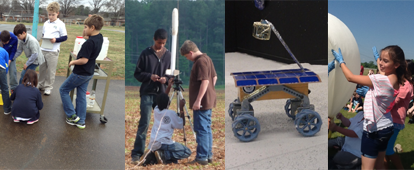STEDTRAIN Background
Problems Addressed:
o Many studies have shown that hands-on experiences are the best teaching tools. Teachers, however, often, especially in the North Alabama-Southern Tennessee area, have very little access to materials and equipment required by hands-on approaches.o Teachers are often over whelmed by technology programs, projects, or expectations imposed on them.
o Effective teaching of technology requires supportive internal and external communities. These are often lacking in most schools.
o The community outside the teaching establishment is, for the most part, quite uninformed and uninvolved in K-12 science and technology education.
Description of the Seed Grant Program:
In the first months of every year the STEDTRAIN Committee issues a Call for Proposals to K-12 schools in North Alabama for innovative projects that will "seed" students enthusiasm for science and technology. Grant amounts requested can range from $200 to $1000.Proposals are evaluated and rated by Committee volunteers according to strict criteria. Awards are made in the August -September timeframe. STEDTRAIN volunteers conduct follow-up visits to assigned grantee teachers. Grantees report on their projects at mid- and end-term. Grantees also prepare poster displays and give brief overviews of their projects at the annual STEDTRAIN Conference, which is held in the Spring.
The program presently is focused on the three north Alabama counties of Madison, Morgan, and Limestone and has been in existence since 1988. Over this period $176,178 has been provided to north Alabama schools and other worthy K-12 programs. Funds for the program are derived from donations from professional organizations, area companies, and individuals. See the link at the upper left for Seed Grant Awards.
How the Seed Grant Program Addresses the Identified Problems:
o Teachers conceive their own projects. They are therefore of a scope and of nature to fit the teachers' needs for technology assimilation and curriculum demands. Furthermore, a self-conceived project is undertaken with more enthusiasm than an imposed one. Such enthusiasm cannot help but be communicated to the students.o New exciting projects generate interest and enthusiasm in fellow teachers and parents. Teachers who are grant recipients soon become technology transfer agents and mentors in their schools. Other teachers in the school see first hand what is being accomplished, become curious, and ask questions about the new technologies or procedures. These other teachers invariably adopt and adapt the new technologies to their own needs and desires for effective teaching.
o The regional nature of the program (currently North Alabama and Southern Tennessee) helps rapid diffusion of technology education and resources throughout the region. Such diffusion is especially needed in rural and some urban areas of this region. Additionally, the fact that a community organization conducts the program reduces the problem of self-interest barriers often exhibited by school systems - barriers which work against widespread diffusions of technology education and resources throughout the region.
o The STEDTRAIN volunteers, most of who are technical professionals, benefit the teachers by providing them with technical insights and personal interest (shown during visits volunteers make to grantee schools). Furthermore the STEDTRAIN volunteers provide valuable feedback to the technical professional community and to the educational establishments.
o The public exposure grant projects receive at the STEDTRAIN Conference helps to inform the outside community about the advantages of teacher-generated, "hands-on" science projects.
o The poster displays and the verbal overviews the grantees give annually generate a community of grantee teachers who learn from one another's experiences and ideas. This is still another kind of supportive community that hastens technology education diffusion.
o Furthermore, the STEDTRAIN volunteers provide valuable feedback to the technical professional community and to the educational establishments.
Some Results of Seed Grants:
A teacher in an "on alert" elementary school used materials purchased with grant funds for math instruction. Youngsters from her class won a national math competition.An "Amusement Park Physics" grant inspired a middle school math class to win a State mathematics competition.
High school youngsters became so proficient in performing DNA analyses (equipment purchased with grant funds) they amazed professionals.
Teachers who have received grant awards have inspired fellow teachers to apply for their own






 Copyright © 2024
Copyright © 2024